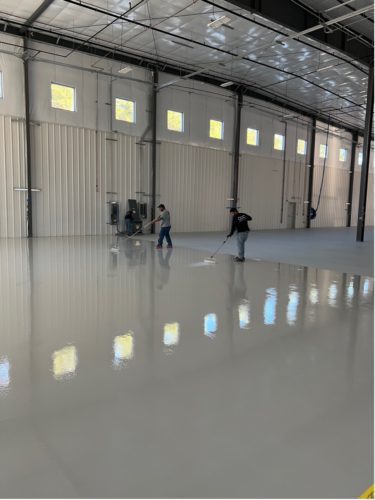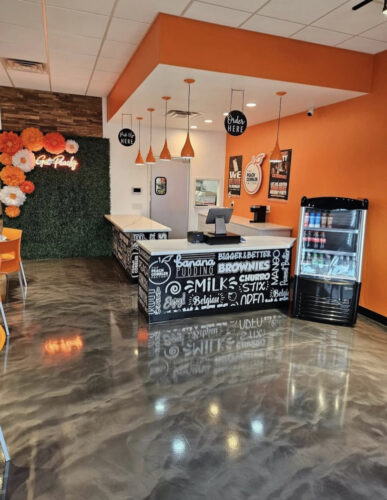
Epoxy flooring is a highly durable and aesthetically versatile flooring option that has gained popularity in various settings, from industrial warehouses to residential garages. It consists of a two-part epoxy that includes a resin and a hardener.
- Resin: Provides the base for the epoxy coating, offering a glossy finish.
- Hardener: Acts as a catalyst to the resin, initiating the curing process that hardens the mixture.
When these two substances are mixed together, they react chemically to form a tough, seamless, and smooth surface. This seamless nature is not only aesthetically pleasing but also functionally significant:
- No Weak Points: Traditional flooring materials, like tiles or pavers, have joints and seams that can become weak points where damage or wear is most likely to occur.
- Hygienic Surface: The absence of seams also prevents the accumulation of dirt, bacteria, and moisture which can degrade the flooring material over time. In settings such as hospitals, kitchens, and clean rooms, this hygienic property is invaluable.
Benefits:
There are several benefits to using epoxy flooring, ranging from its aesthetic appeal to its practical advantages, such as:
- Durability: Epoxy flooring exhibits high compressive strength, which means it can bear heavy loads without cracking or deforming. This makes it suitable for environments where heavy machinery, vehicles, or equipment are used regularly, such as warehouses, factories, and garages.
- Abrasion Resistance: Epoxy floors resist the wear and tear caused by foot traffic, heavy machinery, and chemical exposure. This resistance means that the flooring retains its appearance and structural integrity for extended periods.
- Chemical Resistance: This is particularly beneficial in industrial settings, such as manufacturing plants, laboratories, and automotive workshops where chemical spills are common.
- Hardness and Flexural Strength: The hardness of epoxy makes it resistant to impact and punctures, further enhancing its longevity. Its flexural strength allows it to withstand slight flexing without cracking, which is crucial in environments where the floor may experience minor movements or shifts.
- Low-Maintenance: The smooth, non-porous surface resists stains, spills, and dirt accumulation, helping maintain the floor’s condition.
- Safety: Additives can provide anti-slip qualities to enhance traction.
- Aesthetic Flexibility: Available in numerous colors and patterns to fit any design scheme. Commercial establishments appreciate the shiny high-gloss surface that epoxy can provide, enhancing the brightness of interiors.
- Cost-Effectiveness: Although epoxy flooring may have a higher upfront cost than some traditional flooring materials, its durability and low maintenance requirements often result in cost savings over time. The reduced need for repairs, replacements, and maintenance makes epoxy a cost-effective solution in the long run.
The Application Process of Epoxy Flooring

A critical factor contributing to epoxy flooring’s durability is its ability to form a strong bond with the substrate, often concrete. During installation, the epoxy resin penetrates the pores of the concrete, creating a mechanical bond that anchors the epoxy to the surface. This strong adhesion prevents the epoxy from lifting, cracking, or peeling, even under heavy stress. The application of epoxy flooring involves several steps to ensure proper adhesion and durability:
- Surface Preparation: The concrete must be clean, dry, and free of any contaminants or loose material. This might include diamond grinding or shot blasting the concrete to achieve a suitable profile.
- High-Quality Materials: Use premium coatings to avoid issues post-installation.
- Proper Application: Follow manufacturer guidelines for mixing and application.
- Environmental Factors: Temperature and humidity play a role in the curing process of epoxy. If the environment is too cold or humid during installation, the epoxy may not cure
properly, affecting its hardness and durability. Ensuring optimal curing conditions is crucial for achieving the desired performance characteristics.
The Role of Broadcast Media in Enhancing Durability
Epoxy flooring offers a harmonious blend of utility and style, presenting a wealth of design possibilities suited for various settings. It brings a durable and seamless finish that enhances the aesthetics of any space. A broadcast medium may be used for added durability and traction. Additionally, a textured surface minimizes visible surface wear.

- Quartz Sand Broadcast: Quartz sand is commonly used in industrial settings to enhance the durability of epoxy floors and maximize traction control. The sand adds thickness and creates a rough, textured surface that improves slip resistance and abrasion resistance. Quartz seeded epoxy floors are ideal for environments where slip-and-fall hazards are a concern, such as commercial kitchens, loading docks, and wet processing areas. Due to the sand being so small, often a “double broadcast” is required to mask any patching and create a uniform appearance.
- Flake Broadcast: Colored flakes add both visual appeal and functional benefits to epoxy flooring. The flakes can increase the floor’s thickness, making it more resilient to impact and wear. They also help hide imperfections and minor surface damage, extending the floor’s appearance and durability.
- Metallic Pigments: Metallic pigments are used in epoxy resin to create a shimmering, three-dimensional effect that can simulate the look of rippling water or lava flowing, perfect for making a bold statement.
Epoxy flooring can be customized in terms of thickness and composition to match the expected traffic and load in a particular area. Thicker epoxy layers, often with multiple broadcast media layers, provide greater durability for heavy-duty applications. In contrast, areas with lighter foot traffic may require a less robust application.
Conclusion
Epoxy flooring’s durability is a result of its robust chemical composition, strong adhesion to substrates, and seamless application. It’s ability to withstand heavy loads, resist chemical spills, and endure abrasion makes it an ideal choice for various environments. The addition of broadcast media further enhances its performance, providing additional thickness, slip resistance, and aesthetic options. By considering environmental factors, proper installation practices, and regular maintenance, epoxy flooring can deliver long-lasting, high-performance results that justify its investment.